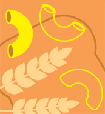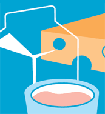- Body
- Fitness
- Nutrition
- Illness &
disability-

- Types of illnesses and disabilities
- Dealing with medical issues
- Coping with your feelings
- Taking care of your body
- Dealing with school
- Relationships
- Becoming independent
- For friends and family
- Stories, celebrities, chats, and other fun stuff
-
Quiz: How much do you know about taking good care of yourself?
-
-
Links to more information
-
-
- Drugs, alcohol
& smoking - Your
feelings - Relationships
- Bullying
- Safety
- Your
future - Environmental
health
Skip section navigation (navigation may have changed)
Section navigation

http://www.girlshealth.gov/
Nutrition
The MyPyramid food guide
MyPyramid is a healthy eating plan that helps you:
- Make smart choices from different food groups
- Keep a healthy weight
- Get plenty of healthy nutrients from the foods you eat
How to read the guide  top
top
The Pyramid has six stripes, each with a different color. The colors stand for different food groups. Do you notice that the stripes have different widths? Orange, green, red, and blue are wide because you should eat plenty of grains, vegetables, fruits, and dairy products. Yellow is narrow because you should limit how much fat you eat each day, even unsaturated fat. Purple, which stands for foods that contatin protein, is between yellow and the other colors.
For lists of foods in each food group, visit Inside the Pyramid and click on each of the colored stripes. Do you see the figure running up the side of the pyramid? It stands for physical activity, which is just as important as healthy eating for preventing disease and keeping a healthy weight. See the Fitness section for more information.
Orange = Grains |  |
Green = Vegetables | |
Red = Fruits | |
Yellow = Oils and fats | |
Blue = Dairy | |
Purple = Meats, beans, fish, poultry | |
How much of each food group do I need?  top
top
The amount of food that you need from each food group depends on the number of calories you need each day. When talking about food, a "calorie" is a measure of the amount of energy you get from eating a certain amount of food. Girls ages 9 to 13 who are moderately active need 1,600 to 2,000 calories each day. Girls ages 14 to 18 who are moderately active need 2,000 calories each day.
To make things simple, let's say that you need 2,000 calories each day. In that case, the numbers in the chart below apply to you:
Mix up your choices within each food group. | |
 | Make half your grains whole. Grains include wheat, rice, oats, cornmeal, and barley. Any food made from a grain is a grain product. Examples include bread, pasta, oatmeal, breakfast cereals, tortillas, and grits. The two types of grains are whole grains and refined grains. The difference between them is that refined grains have been processed to remove parts of the grain. This is done so that the products can sit on the grocery shelf longer without spoiling. But removing parts of the grain also removes fiber and other nutrients. To make sure that you get plenty of nutrients, make at least half the grains you eat each day whole grains. Examples of whole grains include whole-wheat flour, bulgur (cracked wheat), oatmeal, and brown rice. Examples of refined grains are white flour and white rice. Look at the ingredients list on the food package to see if the grains in the food are whole. For instance, on a loaf of bread, look for words like "whole wheat" or "whole cornmeal" in the ingredients list. You should eat six ounces of grains. At least three of the six ounces should be whole grains. |
 | Vary your veggies. The five types of vegetables are: dark green (like spinach, broccoli, and romaine lettuce), orange (like carrots, sweet potatoes, and pumpkin), dry beans and peas (like tofu, split peas, and pinto beans), starchy (like potatoes, green peas, and corn), and other (like celery, tomatoes, and onions). You should eat 2½ cups of vegetables each day. And you should eat a variety of veggies from the five groups throughout the week. |
 | Focus on fruits. Eat a variety of fruits — whether fresh, frozen, canned, or dried — rather than fruit juice for most of your fruit choices. Try melons such as cantaloupe, berries such as blueberries, and citrus fruit such as grapefruit. You should eat 2 cups of fruits each day. |
 | Know your fats. Most of the fats you eat each day should be unsaturated. You should eat no more than 6 teaspoons of oils each day. This includes the oils that you use in cooking, such as olive oil, and the fats in the foods you eat, such as the unsaturated fats in nuts. |
 | Get your calcium-rich foods. Foods rich in calcium include milk and some foods made from milk, including cheese and yogurt. Other foods made from milk — like cream cheese, cream, and butter — are not part of this group because they don't contain much calcium. Most of your milk group choices should be fat-free or low-fat. You should get 3 cups of foods from the milk group each day. |
 | Go lean on protein. This group includes all foods made from red meat (beef, pork, or lamb), poultry (chicken or turkey), fish, eggs, beans, nuts, and seeds. Since fish, nuts, and seeds contain healthy oils, you're better off choosing these rather than meat or poultry. If you do choose meat and poultry, choose cuts that are lean or low-fat. You should eat 5½ ounces from this group each day. |
You may need more or less than 2,000 calories each day. To help you find out how many calories you need and how much of each food group you should eat, go to MyPyramid Plan. Just enter your age, sex, height, weight, and how much physical activity you get on most days. You'll get an eating plan that is tailored just for you!
If you don't want to use measuring cups and a food scale to measure out your food, take a look at the How Much Do YOU Eat? poster. It uses everyday items to help you judge the amounts of various foods. For instance, one cup of broccoli is about the size of a baseball, and 2 to 3 ounces of chicken is about the size of a deck of cards.
How much physical activity do I need?  top
top
Teens should get at least 1 hour of moderate or vigorous physical activity each day. For tips on how to get started, check out the Fitness section from girlshealth.gov.
Should I take vitamin and mineral supplements?  top
top
In general, teens should be able to get all the vitamins and minerals that they need from eating healthy foods. If you are choosing foods wisely, you won't get any extra benefit from taking supplements. If you're not choosing foods wisely, taking supplements is probably not going to make up for your poor eating habits.
The exception is folic acid. Someone who is pregnant or could become pregnant needs 400 micrograms of folic acid daily to lower the risk of major birth defects of her baby's brain or spine.
Content last updated September 22, 2009





